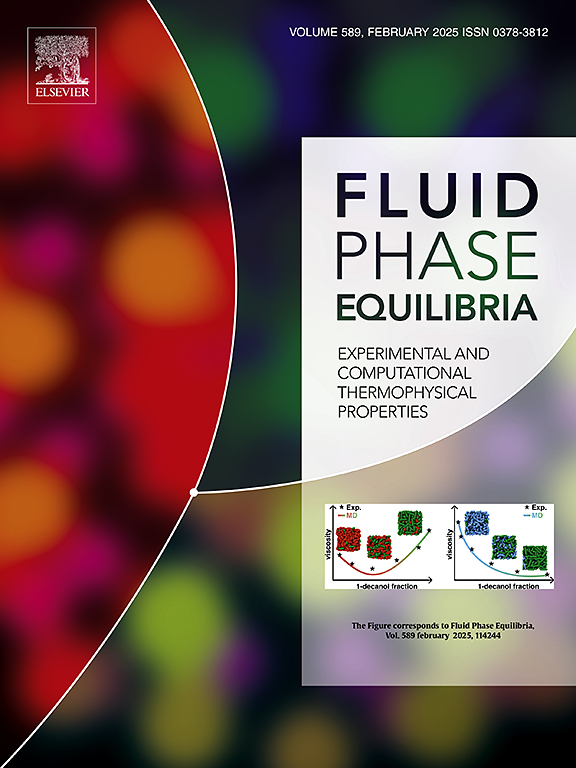液态CO2与乙醇-水混合物的高压相平衡
IF 2.7
3区 工程技术
Q3 CHEMISTRY, PHYSICAL
引用次数: 0
摘要
虽然许多关于CO2(1) -乙醇(2)-水(3)体系的数据已经被报道过,但是对于液态CO2,在建议提取乙醇进行风味分馏的条件下,文献中存在空白。本文采用流动装置测量了CO2 -乙醇-水混合物在(278 ~ 298)K和(8 ~ 20)MPa下的相平衡。乙醇/水的投料比为0.22 ~ 1.7,对应的平衡比为K1(39 ~ 4)、K2(0.12 ~ 0.21)和K3(0.006 ~ 0.04),乙醇/水的选择性β (=K2/K3)为27.9 ~ 5。随着乙醇/水投料比的增加,K2值趋于不变,而K1和K3值变化较大。在本文评价的状态方程中,基于NRTL活度系数表达式的Wong-Sandler混合规则模型的Peng-Robinson状态方程偏差最小,可以将CO2、乙醇和水的K值关联起来,平均相对偏差分别为6.9%、22.3%和28.1%。本文章由计算机程序翻译,如有差异,请以英文原文为准。

High-pressure phase equilibria of liquid CO2 with ethanol - water mixtures
Although many data have been reported for the CO2 (1) - ethanol (2) - water (3) system, gaps in the literature exist for liquid CO2 at conditions where stripping of ethanol for flavor fractionation has been suggested. In this work, a flow-type device was used to measure the phase equilibria of CO2 - ethanol - water mixtures at (278 to 298) K and (8 to 20) MPa. Ethanol/water feed ratios were varied from 0.22 to 1.7 which gave corresponding equilibrium ratios (=yi/xi) of K1 (39 to 4), K2 (0.12 to 0.21) and K3 (0.006 to 0.04) giving ethanol/water selectivities, β (=K2/K3), that ranged from 27.9 to 5. While the K2 values tended to be invariant with ethanol/water feed ratio, the K1 and K3 values varied greatly. Among the equations of state evaluated in this work, the Peng-Robinson equation of state with the Wong-Sandler mixing rule model based on the NRTL activity coefficient expression gave the lowest deviations and could correlate K values for CO2, ethanol and water with an average relative deviation of 6.9 %, 22.3 % and 28.1 %, respectively.
求助全文
通过发布文献求助,成功后即可免费获取论文全文。
去求助
来源期刊

Fluid Phase Equilibria
工程技术-工程:化工
CiteScore
5.30
自引率
15.40%
发文量
223
审稿时长
53 days
期刊介绍:
Fluid Phase Equilibria publishes high-quality papers dealing with experimental, theoretical, and applied research related to equilibrium and transport properties of fluids, solids, and interfaces. Subjects of interest include physical/phase and chemical equilibria; equilibrium and nonequilibrium thermophysical properties; fundamental thermodynamic relations; and stability. The systems central to the journal include pure substances and mixtures of organic and inorganic materials, including polymers, biochemicals, and surfactants with sufficient characterization of composition and purity for the results to be reproduced. Alloys are of interest only when thermodynamic studies are included, purely material studies will not be considered. In all cases, authors are expected to provide physical or chemical interpretations of the results.
Experimental research can include measurements under all conditions of temperature, pressure, and composition, including critical and supercritical. Measurements are to be associated with systems and conditions of fundamental or applied interest, and may not be only a collection of routine data, such as physical property or solubility measurements at limited pressures and temperatures close to ambient, or surfactant studies focussed strictly on micellisation or micelle structure. Papers reporting common data must be accompanied by new physical insights and/or contemporary or new theory or techniques.
 求助内容:
求助内容: 应助结果提醒方式:
应助结果提醒方式:


